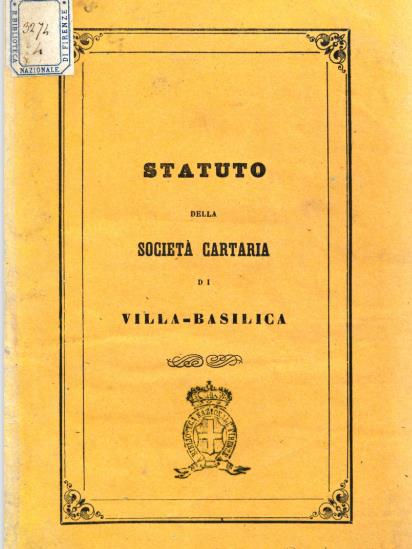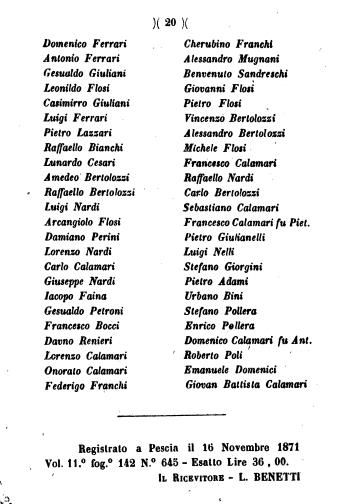The Main Productive Activities: Silk and Iron
Iron.
This is drawn from the fundamental work Medieval Lucca by M. E. Bratchell, which speaks of a volume of business involving large “quantities of iron (sometimes a thousand or 1,000 pounds) sent to Florence. But iron was also imported to Villa Basilica to supply the specialized production of swords and other instruments of war (along with knives and agricultural tools). Some may have been extracted locally; some came from nearby Pescia and, above all, from Pietrabuona.
By the end of the 14th century, iron was also being imported to Villa Basilica from Gello in the vicariate of Coreglia; another 34 were purchased in Borgo a Mozzano. Exports of iron from Borgo a Mozzano to Villa Basilica continued to appear in the local gabella (of Villa Basilica) in the mid-15th century, although perhaps not as prominently. Some of the iron from the Lucchese vicariates of Gallicano and Coreglia may have been mined in Garfagnana, even though at the beginning of the 15th century (as earlier) significant quantities of iron were still being sent to the vicariate of Coreglia.” (p. 176).
Naturally, the activities of smelting and hammer-forging—first with trip hammers and then on the anvil—were carried out directly in the mountains, in a dispersed and widespread workshop network (as P. Pelù wrote), in the various villages and locations where there was wood and charcoal to burn and steep watercourses to power the hammers. But it is clear that the transportation to and from Villa Basilica made use of the Strada di Pizzorna and the village of Pariana.
Silk.
Silk was the most valuable product in the economy of the Lucchese territory, and its processing appears to have been as widespread and scattered as that of iron (and others mentioned). The area of Villa Basilica – as revealed by the Gabelle registers, that is, the tolls showing the passage of goods – provides a picture of activity that is unimaginable today. In the territory there were mulberry plantations to feed the silkworms, and it was women who managed most of the operations. The silkworms (filugelli) were mainly raised and then transported to Lucca or elsewhere, but local silk production and especially cloth weaving also appears.
The only woman who appears in these business records, Riccuccia Tingucci, in Villa Basilica produced fabrics that she then sold in the Montecarlo area.
The following is cited from P. Pelù (Sericulture in Garfagnana and Lucca in the Late Middle Ages and Part of the Sixteenth Century):
“The decentralized operational units – some specialized in reeling, others in spinning, others in the production of veils or the raising of silkworms – were Gallicano, Sillico, Castelnuovo, Castiglione, Cicerana, Pariana, Oneta, Anchiano, Trassilica, San Pellegrino, and finally Villa Basilica (…) which almost always acted as a filter between the valley and the Lucchese businesses.” (p. 350).
But Pariana appears, after Villa Basilica, to be the village that processed silk locally more than any other (with Bartolomeo Benincasa as its leading figure, as we have seen).
To give an idea of the scale of production, the following data are provided:
In 1398, from the area of Villa Basilica came 2,717 pounds of silkworms, 82 pounds of white filugello, 3,071 pounds of raw silk for veils and other uses, and 475 pounds of refined silk.
Note: one Lucchese pound was 0.33 kg. Three pounds made one kilogram.
Pariana was involved, in the years 1389, 1398, 1399, 1405, 1406 (according to data from the Gabelle registers studied), in this silk trade as follows:
From Castelnuovo to Pariana, 140 pounds of filugello for drawing and spinning.

TAILORS AT WORK
Bartolomeo Benincasa, already mentioned, 70 pounds of filugello from Castelnuovo. For drawing and spinning. Bartolomeo di Benincasa, 100 pounds from Gallicano to Pariana for drawing and spinning. Again Bartolomeo Benincasa, 180 pounds of filugello for drawing and spinning from Castelnuovo to Pariana. In 1406 alone, a total of 3,709 pounds of silk and filugelli were moved along the Strada di Pizzorna – and therefore passed through, in whole or in part, Pariana.
Paper.
To speak of paper in Villa Basilica and Pariana is to state the obvious. It was—and still is—a major paper production center in the Lucchese and Tuscan regions. This production, too, developed thanks to the great abundance of water in the mountains. Straw paper was invented here.
Other Activities
A record from the 15th century reveals that a certain Nicola Ianni of Naples had taken on two flocks to oversee for seven nights in the area of Villa Basilica and that, once the period was over, he moved to Pariana, which confirms its role as a place of hospitality. This is documentation of transhumance, which from the Apennine mountains extended both to the Plain of Lucca and Florence and to the Maremma.
The gabelle record tolls and thus movements: in 1399, forty-five people from Pariana, Villa Basilica, Boveglio, and Colognora paid the tax for woolen cloth they were transporting.
Naturally, there were also the other types of production we have mentioned multiple times. But an irreplaceable and essential activity for the survival of the mountain—and above all for the city, which did not produce but depended on its countryside—always remained agriculture, livestock farming, and forestry. And for many centuries, what sustained these autonomous communities were the communal goods and lands: those lands that had no private ownership but belonged undivided to all inhabitants (not outsiders, as the Statutes state, who had no right to them) of the community.
A Final Overview
The map that follows – which captures the situation of the last centuries before the modern era (17th–18th centuries) – highlights the border between the States of Lucca and Florence (Vicariate of Villa Basilica and Vicariate of Pescia), referencing many of the details found in this Historical Guide.
The locations of Battifolle and Monte dell’Uso (called Uso Comune) are shown. The Ponte del Mercato can also be seen, along the Via di Pescia, which comes from Pariana to Villa Basilica and crosses the Pescia River.
In the legend, a Selvareggia is mentioned, which is interesting because a similar toponym is referenced in a document by Matilda of Canossa in the heart of the Middle Ages.



